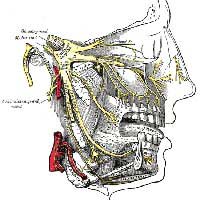Trigeminal Neuralgia: Does it Cause Headaches?

Trigeminal neuralgia is a condition that is caused by pressure on the trigeminal nerve. This is one of the main nerves that comes out of the spine – it and its branches are responsible for our ability to feel sensations in our face and upper head. Common causes of the underlying pressure include pressure from an artery, which may have become distorted because of atherosclerotic changes, or from inflammation in surrounding tissues. It can also result from the nerve damage that develops in people with multiple sclerosis.
What Does Trigeminal Neuralgia Feel Like?
The pain of trigeminal neuralgia is very intense, a stabbing pain that last for a couple of minutes and is very off-and-on. Attacks can last for several hours, and occur in bouts that can last for weeks. Remission periods then occur, with no pain for long periods as the nerve settles down, or treatment is effective.The place where the pain is felt depends on the part of the trigeminal nerve that is affected. This nerve has three main branches. One leads to the upper part of the head, the forehead, the top of the scalp and the eyebrow area above the eye. Neuralgia that affects this part of the nerve does cause headaches, as the pain is concentrated in the forehead, around the eye and at the top of the skull. The second branch supplies the cheek, upper jaw, the side of the nose and the gums and teeth. Pain here can be referred up to the temple but neuralgia of this branch of the trigeminal nerve usually causes facial pain. Likewise, pressure on the mandibular branch that supplies the lower jaw and the bottom set of teeth and gums, causes lower facial pain.
Trigeminal Neuralgia and Cluster Headaches
There are several similarities between the headaches that are experienced by people with trigeminal neuralgia and cluster headaches. Both involve severe headache with the pain concentrated around one side of the face, usually around the eye and at the temple. Both also occur in clusters – headaches are experienced every couple of days for a few weeks or even months – but then no pain for months in between. The pain often occurs in the same side of the head, rather than swapping over or being at the back of the head, for example.The two conditions are, however, not the same and there are also important differences. Headaches that are caused by trigeminal neuralgia often start in the day – cluster headaches commonly start at night. Trigeminal neuralgia headaches can be set off just by touching the face, but this doesn’t start of a cluster headache, and posture makes no difference. With cluster headaches, lying down makes the pain much worse and they can make the eyes red and watery. Cluster headaches involve severe and steady pain, whereas trigeminal neuralgia headaches have spikes of pain, with a dull ache in between.
Treating Pain from Trigeminal Neuralgia
The treatment for trigeminal neuralgia is completely different from the therapy for headaches. Usual pain killers do not have any effect. The main treatment involves taking a drug also used to treat epilepsy and to stabilise mood on people with bipolar disorder or manic behaviour syndromes. Carbamazepine has been used to treat trigeminal neuralgia since the 1960s. Low doses are tried at first, with gradual increments until the pain is under control.This drug has many side effects, so is not an ideal treatment. Some people cannot tolerate it, or it fails to make any difference to their pain. In these cases, a neurologist needs to do a thorough investigation as to the cause and site of the problem and may need to provide different drugs that work in different ways. Lamotrigine and gabapentin can also be used. All the drugs work by changing the say nerve impulses pass along the trigeminal nerve, making it less able to transmit signals. With a lower activity in the nerve, the pressure has less of an effect, so the pain is reduced.
If drug treatment with these different types of medicine still has no effect, there are also several surgical treatments. These involve either relieving the pressure on the nerve, or blocking the nerve activity completely by freezing, heating or compressing the nerve beyond the pressure point. This can completely remove the pain, but it can leave parts of the skin on the head and face feeling numb.






